sensor TOYOTA CAMRY HYBRID 2020 (in English) Repair Manual
[x] Cancel search | Manufacturer: TOYOTA, Model Year: 2020, Model line: CAMRY HYBRID, Model: TOYOTA CAMRY HYBRID 2020Pages: 592, PDF Size: 12.15 MB
Page 336 of 592
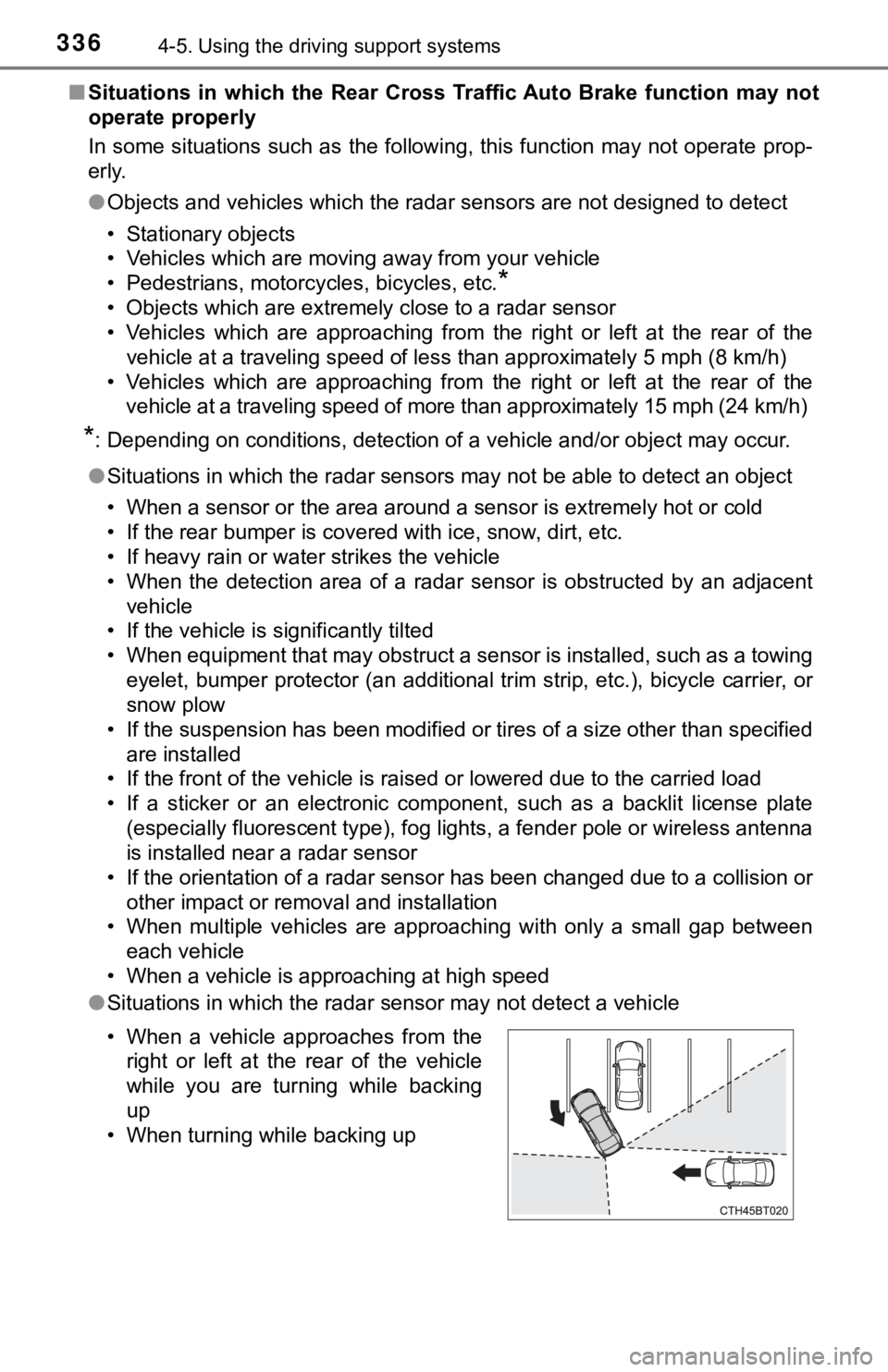
3364-5. Using the driving support systems
■Situations in which the Rear Cross Traffic Auto Brake function may not
operate properly
In some situations such as the following, this function may not operate prop-
erly.
● Objects and vehicles which the radar sensors are not designed t o detect
• Stationary objects
• Vehicles which are moving away from your vehicle
• Pedestrians, motorcycles, bicycles, etc.
*
• Objects which are extremely close to a radar sensor
• Vehicles which are approaching from the right or left at the r ear of the
vehicle at a traveling speed of less than approximately 5 mph ( 8 km/h)
• Vehicles which are approaching from the right or left at the r ear of the
vehicle at a traveling speed of more than approximately 15 mph (24 km/h)
*: Depending on conditions, detection of a vehicle and/or object may occur.
● Situations in which the radar sensors may not be able to detect an object
• When a sensor or the area around a sensor is extremely hot or cold
• If the rear bumper is covered with ice, snow, dirt, etc.
• If heavy rain or water strikes the vehicle
• When the detection area of a radar sensor is obstructed by an adjacent
vehicle
• If the vehicle is significantly tilted
• When equipment that may obstruct a sensor is installed, such a s a towing
eyelet, bumper protector (an additional trim strip, etc.), bicy cle carrier, or
snow plow
• If the suspension has been modified or tires of a size other than specified
are installed
• If the front of the vehicle is raised or lowered due to the ca rried load
• If a sticker or an electronic component, such as a backlit license plate
(especially fluorescent type), fog lights, a fender pole or wir eless antenna
is installed near a radar sensor
• If the orientation of a radar sensor has been changed due to a collision or
other impact or removal and installation
• When multiple vehicles are approaching with only a small gap between each vehicle
• When a vehicle is approaching at high speed
● Situations in which the radar sensor may not detect a vehicle
• When a vehicle approaches from the
right or left at the rear of the vehicle
while you are turning while backing
up
• When turning while backing up
Page 337 of 592
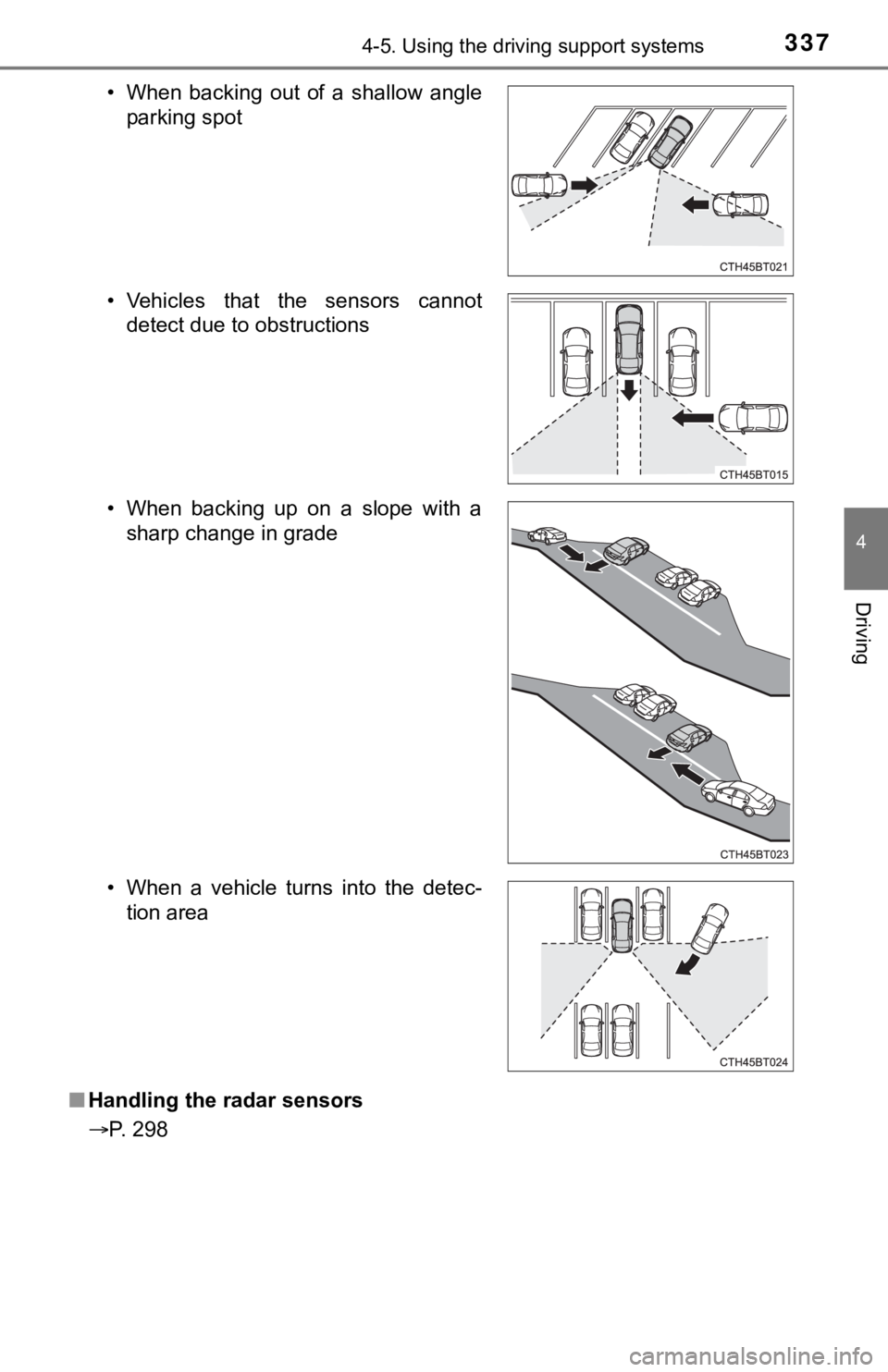
3374-5. Using the driving support systems
4
Driving
■Handling the radar sensors
P. 298• When backing out of a shallow angle
parking spot
• Vehicles that the sensors cannot detect due to obstructions
• When backing up on a slope with a sharp change in grade
• When a vehicle turns into the detec- tion area
Page 354 of 592
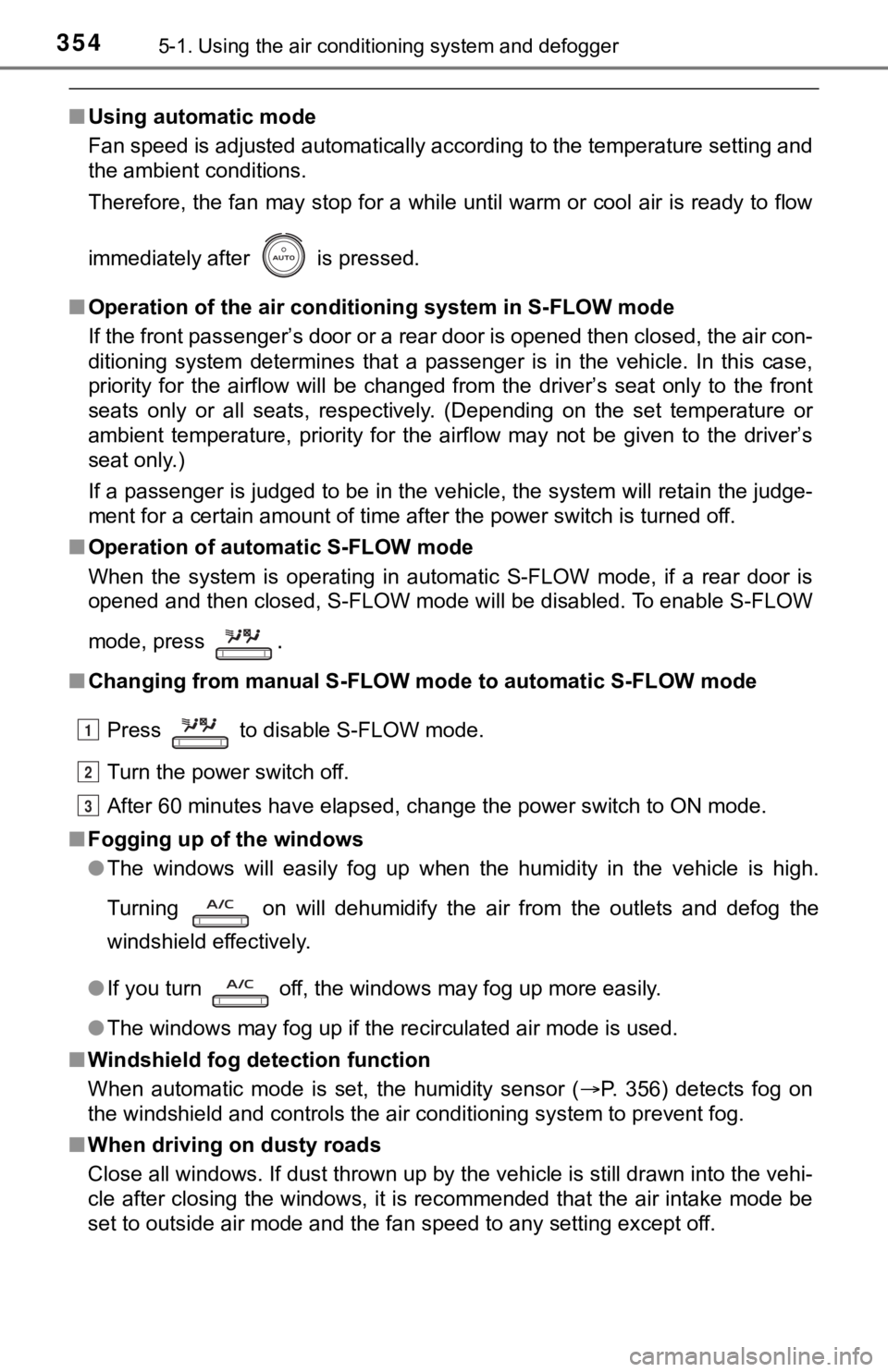
3545-1. Using the air conditioning system and defogger
■Using automatic mode
Fan speed is adjusted automatically according to the temperatur e setting and
the ambient conditions.
Therefore, the fan may stop for a while until warm or cool air is ready to flow
immediately after is pressed.
■ Operation of the air condit ioning system in S-FLOW mode
If the front passenger’s door or a rear door is opened then clo sed, the air con-
ditioning system determines that a passenger is in the vehicle. In this case,
priority for the airflow will be changed from the driver’s seat only to the front
seats only or all seats, respectively. (Depending on the set temperature or
ambient temperature, priority for the airflow may not be given to the driver’s
seat only.)
If a passenger is judged to be in the vehicle, the system will retain the judge-
ment for a certain amount of time after the power switch is tur ned off.
■ Operation of automatic S-FLOW mode
When the system is operating in automatic S-FLOW mode, if a rea r door is
opened and then closed, S-FLOW mode will be disabled. To enable S-FLOW
mode, press
.
■ Changing from manual S-FLOW mode to automatic S-FLOW mode
Press
to disable S-FLOW mode.
Turn the power switch off.
After 60 minutes have elapsed, change the power switch to ON mo de.
■ Fogging up of the windows
●The windows will easily fog up when the humidity in the vehicle is high.
Turning on will dehumidify the air from the outlets and defog the
windshield effectively.
● If you turn off, the windows may fog up more easily.
● The windows may fog up if the recirculated air mode is used.
■ Windshield fog detection function
When automatic mode is set, the humidity sensor (P. 356) detects fog on
the windshield and controls the air conditioning system to prev ent fog.
■ When driving on dusty roads
Close all windows. If dust thrown up by the vehicle is still drawn into the vehi-
cle after closing the windows, it is recommended that the air i ntake mode be
set to outside air mode and the fan speed to any setting except off.1
2
3
Page 356 of 592
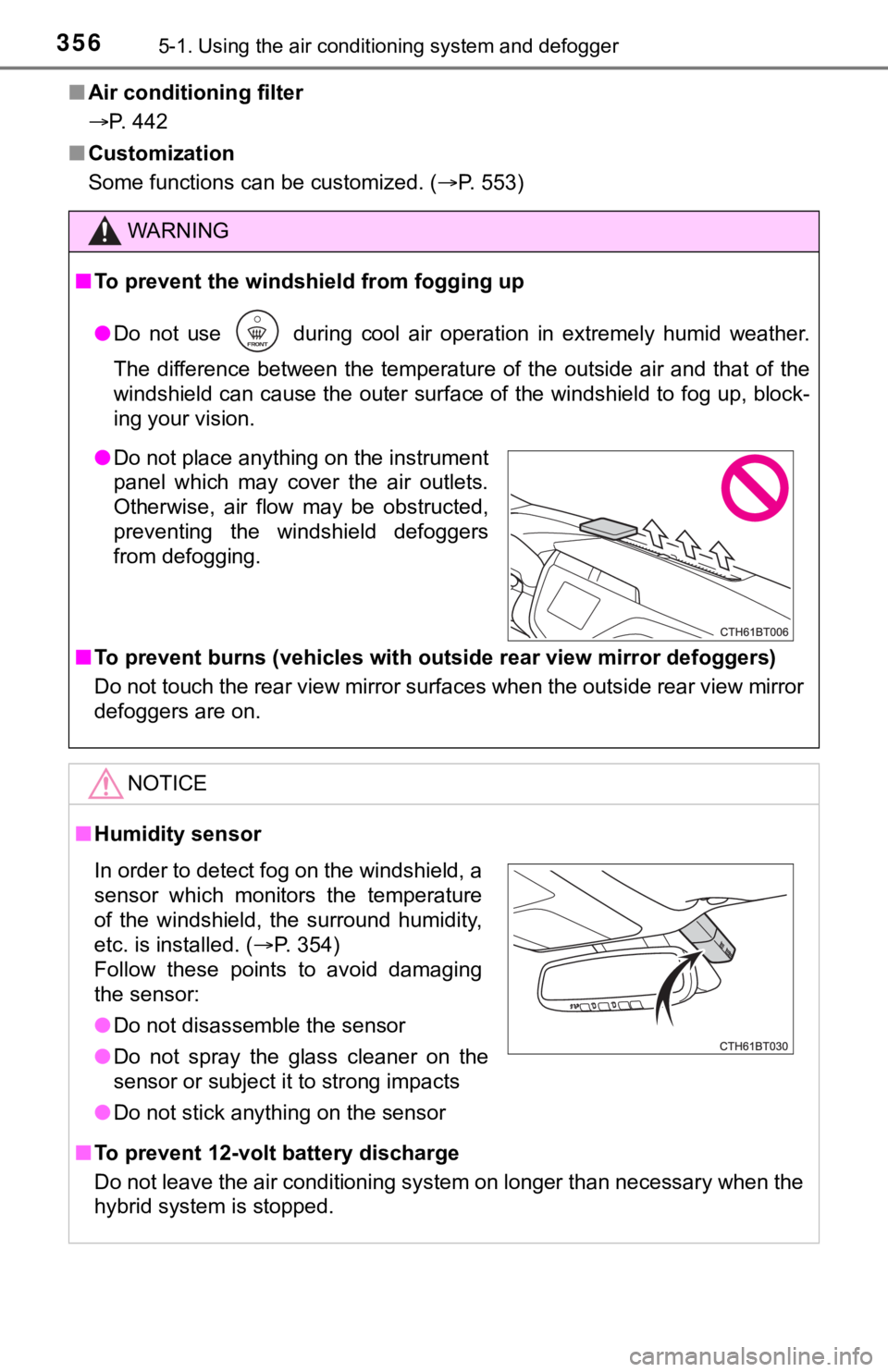
3565-1. Using the air conditioning system and defogger
■Air conditioning filter
P. 442
■ Customization
Some functions can be customized. ( P. 553)
WARNING
■To prevent the windshield from fogging up
● Do not use during cool air operation in extremely humid weathe r.
The difference between the temperature of the outside air and t hat of the
windshield can cause the outer surface of the windshield to fog up, block-
ing your vision.
■ To prevent burns (vehicles with outside rear view mirror defogg ers)
Do not touch the rear view mirror surfaces when the outside rea r view mirror
defoggers are on.
NOTICE
■ Humidity sensor
■ To prevent 12-volt b attery discharge
Do not leave the air conditioning system on longer than necessa ry when the
hybrid system is stopped.
● Do not place anything on the instrument
panel which may cover the air outlets.
Otherwise, air flow may be obstructed,
preventing the windshield defoggers
from defogging.
In order to detect fog on the windshield, a
sensor which monitors the temperature
of the windshield, the surround humidity,
etc. is installed. ( P. 354)
Follow these points to avoid damaging
the sensor:
● Do not disassemble the sensor
● Do not spray the glass cleaner on the
sensor or subject it to strong impacts
● Do not stick anything on the sensor
Page 426 of 592

4266-3. Do-it-yourself maintenance
◆Registering ID codes
Vehicles without a tire inflation pressure display function
Every tire pressure warning valve and transmitter has a unique ID
code. In addition to the set of tire pressure warning system se nsor
ID codes initially registered to the vehicle, a second set of ID codes
can be registered.
A second set of tire pressure warning system sensor ID codes ca n
be registered at your Toyota dealer. When 2 sets of ID codes ha ve
been registered, either ID code set can be selected.
Vehicles with a tire inflation pressure display function
Every tire pressure warning valve and transmitter has a unique ID
code. When replacing a tire pressure warning valve and transmit ter,
it is necessary to reg ister the ID codes.
The ID codes can be registered on (4.2-inch display) or (7-
inch display) of the multi-information display.
■Changing the available set of ID codes (vehicles without a tire
inflation pressure display function)
When 2 sets of ID codes are reg istered, the corresponding ID code
set for the installed wheels can be selected on (4.2-inch disp lay)
or (7-inch display) of the multi-information display. It is no t nec-
essary to reregister the ID codes each time the wheels are
changed.
For information regarding changing the registered ID codes for an
ID code set, contact your Toyota dealer.
■How to register the ID codes (vehicles with a tire inflation pr es-
sure display function)
Park the vehicle in a safe place, wait for approximately 20 min -
utes, and then start t he hybrid system. (P. 208)
Select (4.2-inch display) or (7-inch display) on the multi-
information display using the meter control switches on the ste er-
ing wheel. ( P. 111, 125)
4.2-inch display: Select “Vehi cle Settings” and then press .
7-inch display: Select and then press and hold .
Select “TPWS” and then press .
1
2
3
4
Page 477 of 592
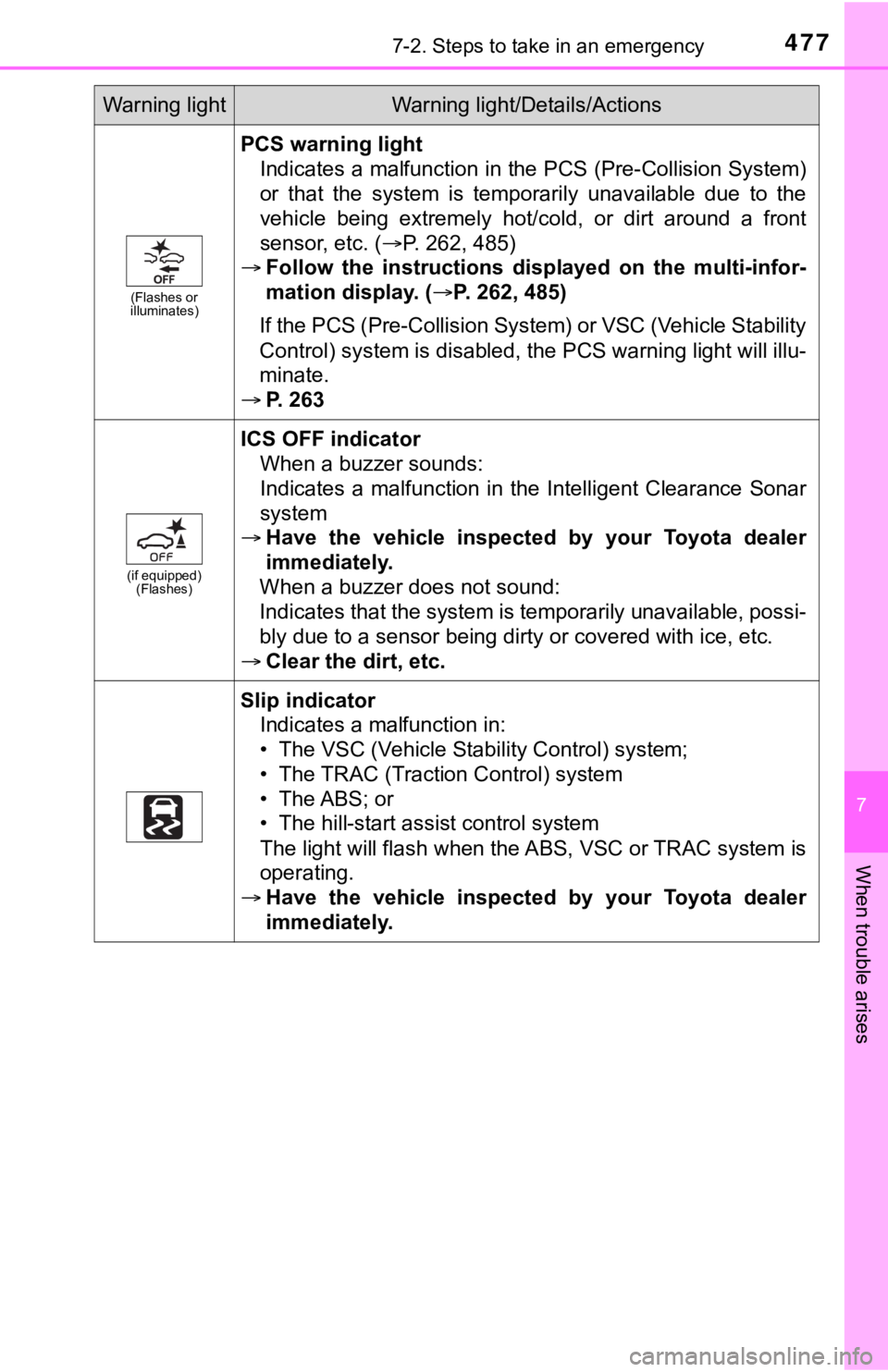
4777-2. Steps to take in an emergency
7
When trouble arises
(Flashes or
illuminates)
PCS warning light
Indicates a malfunction in the PCS (Pre-Collision System)
or that the system is temporarily unavailable due to the
vehicle being extremely hot/cold, or dirt around a front
sensor, etc. ( P. 262, 485)
Follow the instructions displayed on the multi-infor-
mation display. (P. 262, 485)
If the PCS (Pre-Collision System) or VSC (Vehicle Stability
Control) system is disabled, the PCS warning light will illu-
minate.
P. 263
(if equipped)
(Flashes)
ICS OFF indicator
When a buzzer sounds:
Indicates a malfunction in the Intelligent Clearance Sonar
system
Have the vehicle inspected by your Toyota dealer
immediately.
When a buzzer does not sound:
Indicates that the system is temporarily unavailable, possi-
bly due to a sensor being dirty or covered with ice, etc.
Clear the dirt, etc.
Slip indicator
Indicates a malfunction in:
• The VSC (Vehicle Stability Control) system;
• The TRAC (Traction Control) system
• The ABS; or
• The hill-start assist control system
The light will flash when the ABS, VSC or TRAC system is
operating.
Have the vehicle inspected by your Toyota dealer
immediately.
Warning lightWarning light/Details/Actions
Page 480 of 592

4807-2. Steps to take in an emergency
■SRS warning light
This warning light system monitors the airbag sensor assembly, front impact
sensors, side impact sensors (front door), side impact sensors (front), side
impact sensors (rear), driver’s seat position sensor, driver’s seat belt buckle
switch, front passenger occupant classification system (ECU and sensors),
“AIRBAG ON” indicator light, “A IRBAG OFF” indicator light, seat belt preten-
sioners, airbags, interconnecting wiring and power sources. (P. 36)
■ Front passenger detection sensor, seat belt reminder and warnin g
buzzer
● If luggage is placed on the front passenger seat, the front pas senger detec-
tion sensor may cause the warning light to flash and the warnin g buzzer to
sound even if a passenger is not sitting in the seat.
● If a cushion is placed on the seat, the sensor may not detect a passenger,
and the warning light may not operate properly.
■ If the malfunction indicator lamp comes on while driving
First check the following:
●Is the fuel tank empty?
If it is, fill the fuel tank immediately.
● Is the fuel tank cap loose?
If it is, tighten it securely.
The light will go off after several driving trips.
If the light does not go off even after several trips, contact your Toyota dealer
as soon as possible.
Page 552 of 592
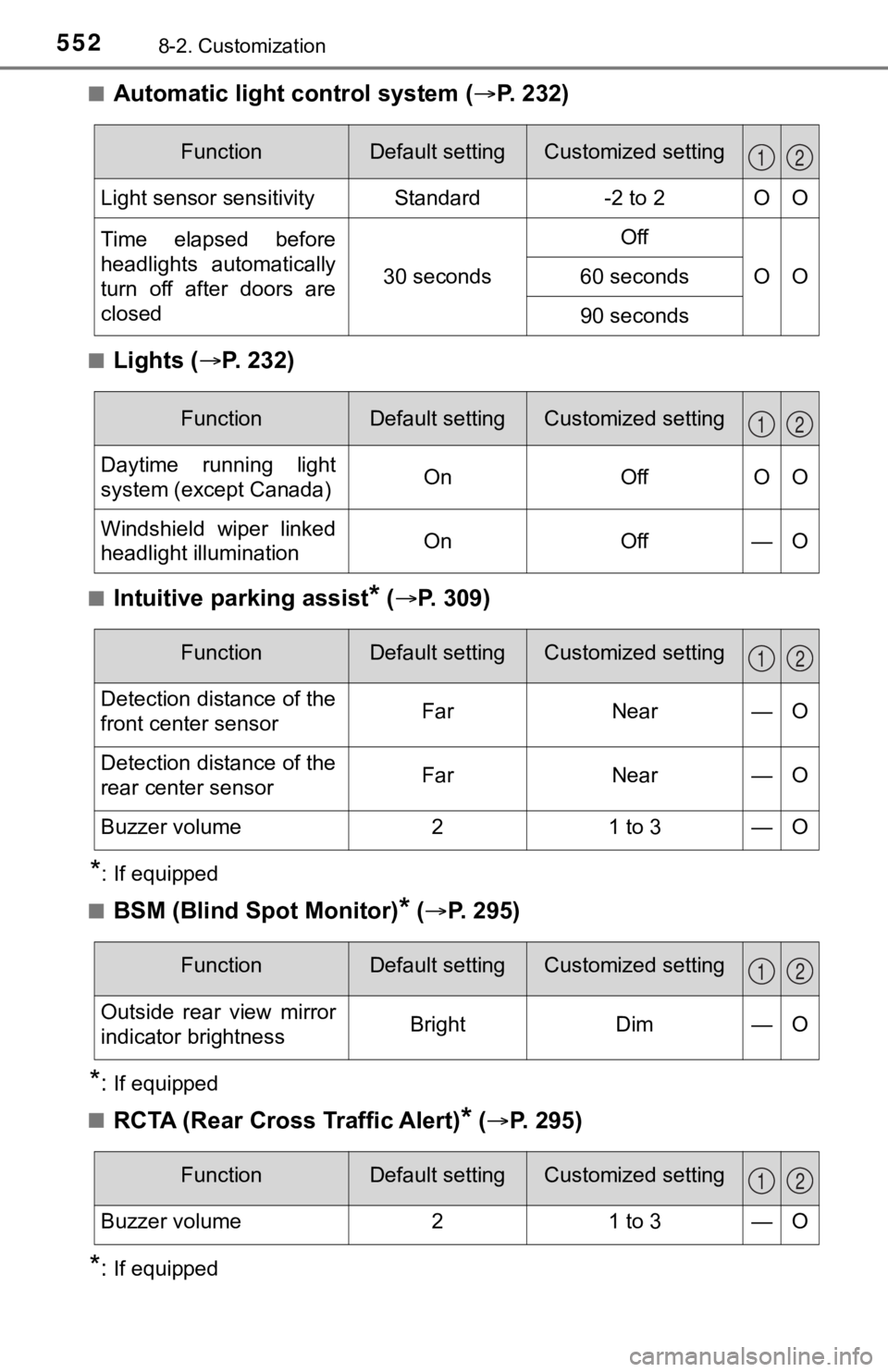
5528-2. Customization
■Automatic light control system (P. 2 3 2 )
■Lights ( P. 232)
■Intuitive parking assist* ( P. 309)
*: If equipped
■
BSM (Blind Spot Monitor)* ( P. 295)
*:If equipped
■
RCTA (Rear Cross Traffic Alert)* ( P. 295)
*:If equipped
FunctionDefault settingCustomized setting
Light sensor sensitivityStandard-2 to 2OO
Time elapsed before
headlights automatically
turn off after doors are
closed
30 seconds
Off
OO60 seconds
90 seconds
12
FunctionDefault settingCustomized setting
Daytime running light
system (except Canada)OnOffOO
Windshield wiper linked
headlight illuminationOnOff—O
12
FunctionDefault settingCustomized setting
Detection distance of the
front center sensorFarNear—O
Detection distance of the
rear center sensorFarNear—O
Buzzer volume21 to 3—O
12
FunctionDefault settingCustomized setting
Outside rear view mirror
indicator brightnessBrightDim—O
12
FunctionDefault settingCustomized setting
Buzzer volume21 to 3—O
12
Page 574 of 592
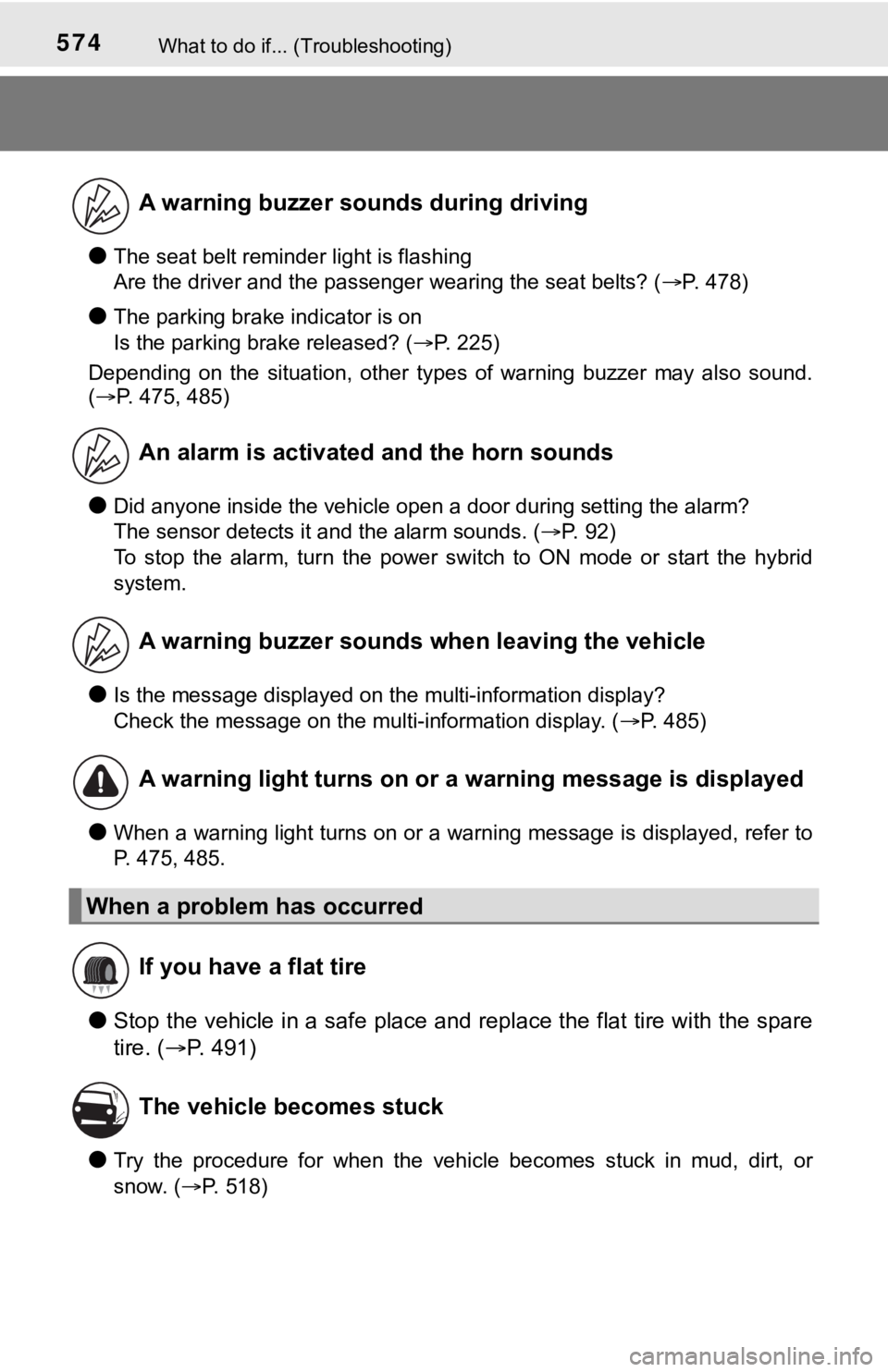
574What to do if... (Troubleshooting)
●The seat belt reminder light is flashing
Are the driver and the passenger wearing the seat belts? (P. 478)
●The parking brake indicator is on
Is the parking brake released? (P. 225)
Depending on the situation, other types of warning buzzer may also sound.
( P. 475, 485)
●Did anyone inside the vehicle open a door during setting the al arm?
The sensor detects it and the alarm sounds. ( P. 92)
To stop the alarm, turn the power switch to ON mode or start th e hybrid
system.
●Is the message displayed on the multi-information display?
Check the message on the multi-information display. ( P. 485)
●When a warning light turns on or a warning message is displayed , refer to
P. 475, 485.
●Stop the vehicle in a safe place and replace the flat tire with the spare
tire. ( P. 491)
●Try the procedure for when the vehicle becomes stuck in mud, di rt, or
snow. ( P. 518)
A warning buzzer sounds during driving
An alarm is activated and the horn sounds
A warning buzzer sounds w hen leaving the vehicle
A warning light turns on or a warning message is displayed
When a problem has occurred If you have a flat tire
The vehicle becomes stuck
Page 587 of 592
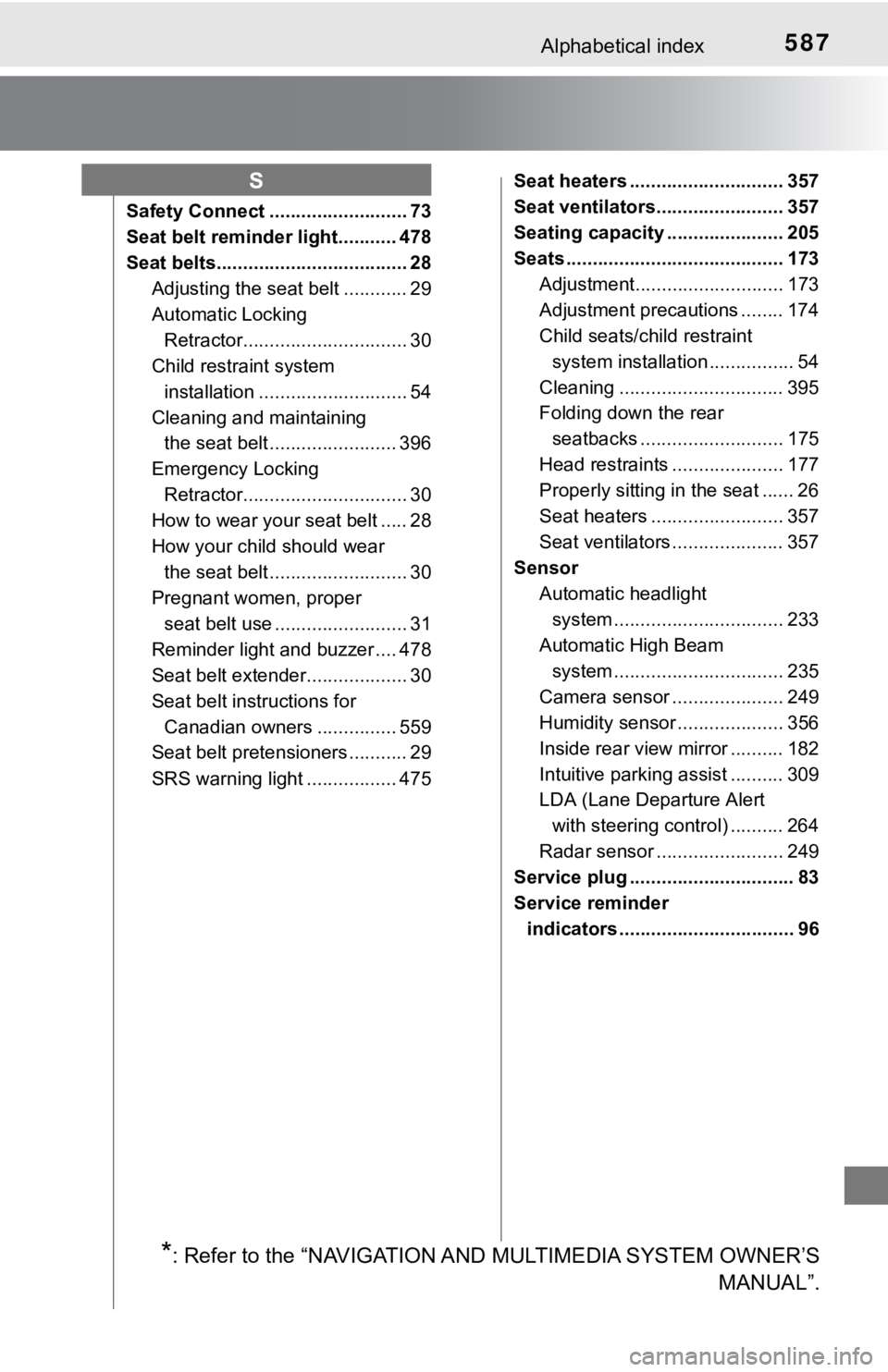
587Alphabetical index
Safety Connect .......................... 73
Seat belt reminder light........... 478
Seat belts.................................... 28Adjusting the seat belt ............ 29
Automatic Locking
Retractor............................... 30
Child restra int system
installation ............................ 54
Cleaning and maintaining the seat belt ........................ 396
Emergency Locking Retractor............................... 30
How to wear your seat belt ..... 28
How your child should wear
the seat belt .......................... 30
Pregnant women, proper
seat belt use ......................... 31
Reminder light and buzzer .... 478
Seat belt extender................... 30
Seat belt instructions for Canadian owners ............... 559
Seat belt pretensioners ........... 29
SRS warning light ................. 475 Seat heaters ............................. 357
Seat ventilators........................ 357
Seating capacity ...................... 205
Seats ......................................... 173
Adjustment............................ 173
Adjustment precautions ........ 174
Child seats/child restraint system installation . ............... 54
Cleaning ............................... 395
Folding down the rear seatbacks ........................... 175
Head restraints ..................... 177
Properly sitting in the seat ...... 26
Seat heaters ......................... 357
Seat ventilators ..................... 357
Sensor
Automatic headlight system .......... ...................... 233
Automatic High Beam
system .......... ...................... 235
Camera sensor ..................... 249
Humidity sensor .................... 356
Inside rear view mirror .......... 182
Intuitive parking assist .......... 309
LDA (Lane Departure Alert with steering control) .......... 264
Radar sensor ........................ 249
Service plug ............................... 83
Service reminder
indicators ................................. 96
S
*: Refer to the “NAVIGATION AND MULTIMEDIA SYSTEM OWNER’S MANUAL”.